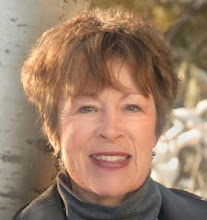 |
| "On the Portal, Ghost Ranch, 1959" Photo by Todd Webb, © 2010* |
Last August after Karen Young and I began making plans for the 2012 Year of Remarkable Taos Women, Canadian poet and author Kate Braid contacted me. One of her favorite painters is Georgia O’Keeffe. Kate spent a week in Taos some years ago. Inspired by the landscape, history and people – and some recent research she’d conducted on Georgia, she went on to write a book of poems that “document” Georgia’s journal of an imaginary trip with Emily Carr, Canada’s iconic woman painter. Nominated for several prizes, including the Pat Lowther Award for Best Book of Poems by a Canadian Woman, Kate’s book, Inward to the Bones: Georgia O'Keeffe’s Journey with Emily Carr, won the VanCity Women's Book Prize in Vancouver, British Columbia.
One of Kate’s poems (below) inspired this blog posting. I remembered reading how two series of photographs by Georgia’s husband Alfred Stieglitz had helped develop a mystique around O’Keeffe, in particular his photographs from the 1930s. These portraits, released to the press in the 1910s and 1920s, contributed to the legend that grew up around her: descriptions of her personality ranged from aloof to enigmatic to reserved.
On reading her letters, however, I discovered a more complex personality, the real Georgia. One she penned in April 1929, a week before leaving New York for New Mexico, illustrates her reluctance to leave Stieglitz (who had suffered a severe heart attack the previous September). She wrote: “If I can keep up my courage and leave Stieglitz I plan to go West the beginning of next week for two months. It is always such a struggle for me to leave him.”
Kate Braid portrayed that aspect in this poem (from Part II, “New Mexico: Light over Water”):
28.
I pack the suitcase, trembling with excitement.And fear. Alfred will miss me.
He is so fragile, so tragic.His long white fingers play with my valise,His eyes cast down in sorrow.
But I must go—It is for my spirit, for my life.
Kate also captured O’Keeffe’s anticipation. Then experiencing an ebb in her career, a time when she considered her painting weak, she needed a change, a new world of possibilities. In 1916 Georgia had found inspiration in the west Texas landscape, in the contrasts between color, form and shape, after her move to Canyon. The New Mexico landscape, viewed briefly during a visit to Santa Fe in 1917, had also captured her imagination.
How Georgia got to Taos is a long story, but at Mabel’s invitation she and her friend and fellow painter Rebecca Strand (then married to the well-known American photographer Paul Strand) arrived there in May 1929. Mabel put them up in the Pink House, and gave Georgia her own studio to work in.
That summer in northern New Mexico changed O’Keeffe’s world forever. What happened to her comes out in letters. Just days after their arrival Rebecca wrote to Stieglitz telling him how much greater the opportunity to work was, how she and Georgia both felt active and alive in Taos away from all the distractions of the city. Sometime that summer O’Keeffe wrote her friend Henry McBride(art critic for the New York Sun)”You know I never feel at home in the East like I do out here—and finally feeling in the right place again—I feel like myself—and I like it—and I like what Mabel has dug up out of the Earth here…” At the end of her stay, O’Keeffe expressed her appreciation to Mabel (who was absent from Taos most of the summer):
I wish I could see you this morning—more than that I could tell you how important these months have been to me—Maybe you know—I am ready to go now—in every way—If you were here I could tell you quite definitely how it came about—it is some thing so perfect—so perfect for ending this and beginning a new thing—(August 1929)**
In the process of beginning the “new thing”—paintings inspired by the folk art, architecture, light and landscape of Taos—Georgia also found herself. From 1929 until her death in 1986, O’Keeffe captured the vast New Mexico sky, the canyons and cliffs around Abiquiu, and bones bleached in the desert sun. These images became her signature paintings. And it all started at Mabel’s in Taos.
For me, Kate Braid’s last poem (from Part IV, “Inward the Bones”) encapsulates O’Keeffe’s long life and painting career. It provides the perfect ending to this posting.
87.
I dream a wild wind over my bare bones,a terrifying song through the cavities of my skull,my hips. The thin digits of what once werearticulating fingers, trail paint.
I am reduced to light wind.I can feel myself inside this bodylike hills, like a vaulted room,like spans or poles setbone-deep in pearly earth
A dark shell falls away, light risingthrough translucent flesh.I am haunted by skeletons, stripped cleanof blood and dirt.Shaken, I vibrate to the sensationsthat were once this body. The wind whistlesmusic through these bones.
Before I sign off, I’m pleased to announce that Kate has promised to contribute something in the future about her experience writing these terrific, moving poems on O’Keeffe.
Adios for now,
Liz
* Cover photo to Inward to the Bones: Georgia O'Keeffe’s Journey with Emily Carr (2010) by Kate Braid courtesy of Caitlin Press, Half Moon Bay, British Columbia.
** Quotes from this and other letters excerpted from Georgia O’Keeffe: Art and Letters by Jack Cowart, Juan Hamilton, and Sarah Greenough. Washington : National Gallery of Art ; Boston : New York Graphic Society Books, 1987.
